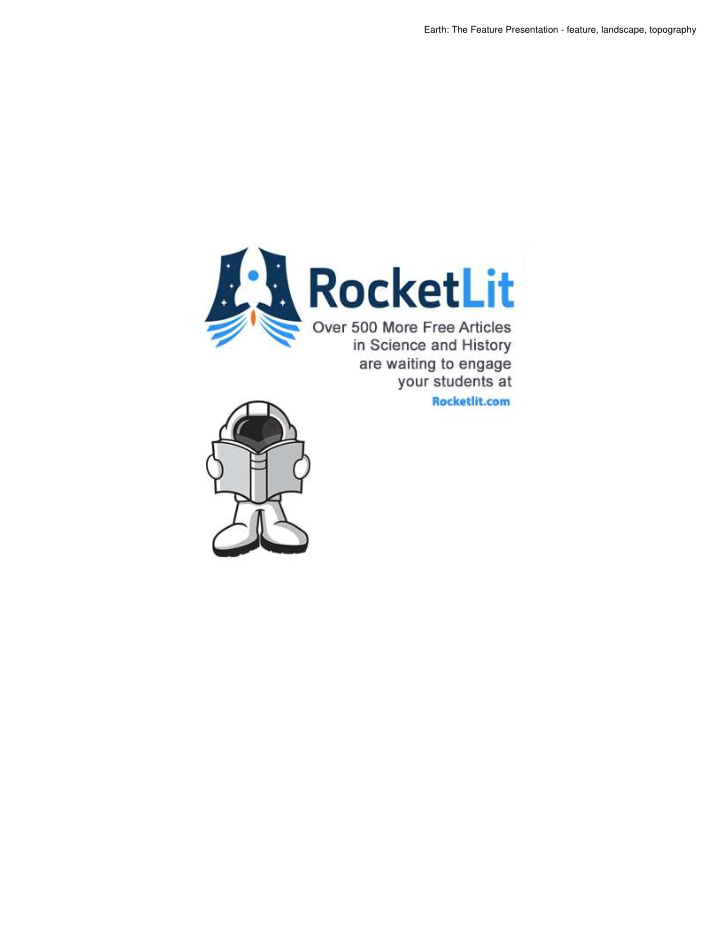



Earth: The Feature Presentation - feature, landscape, topography
Earth: The Feature Presentation feature, landscape, topography Erosion and Weathering Unit How would you describe your mom to someone who's never met her? You might talk about the color of her eyes, the shape of her face, and her height. You might describe the scar from when she broke her nose. You have created a picture of your mom. We make pictures of the Earth, too. They're called maps. Maps show us what the surface of the Earth looks like. But what sort of words would you use to explain the world around you? Your face has two eyes, a nose, and a mouth. Your body has arms, legs, hands, and feet. The Earth is made up of pieces like mountains, valleys, and smooth plains. The Earth also has places where oil, gold, and even water flow under the ground. Each of these things is a feature , which is something that formed naturally on the surface of the Earth or underneath the Earth's surface. Features are one way we can describe what the Earth looks like. If you put your mother's eyes, nose and mouth together, you get her face. She may have a few lines and marks on her face. If you put all the parts of her face together, you get a whole picture of her face. The wrinkles and the scars show how her face has changed over time. The Earth works the same way. If you add up all the Earth's features in one place, you get a picture of the land in that place. It also shows what's happened there in the past. A landscape is all the features in an area put together. When you put the mountains, plains, rivers and everything else together, you get a landscape. If you took a picture of only your mother, would someone be able to tell how tall she is from the picture? What if you put a ruler next to her and took a picture? Now someone could see how tall she is. Maps show mountains, valleys and rivers. But how high is that mountain? How deep is that valley? A map that Over 500 more free Science and History articles are waiting to inspire your students at Rocketlit Page 2
Earth: The Feature Presentation - feature, landscape, topography shows shape and height would be more helpful. Topography is the study of the shape of the land, especially how tall or deep down things go. Topographic maps use special lines that work like rulers to show you how high a mountain is and how steep its slope is. Our Earth is always changing. New mountains form, while older mountains wear down from wind and water. Over time rocks build up and change the way rivers flow. When we talk about what the Earth looks like, we describe its features, the same way you would describe the parts of your mother's face to make a picture of her. When you put these pictures together, they form a landscape or a whole picture of a place that shows how it has changed over time. Add height to your description, and you get topography, just like when you added that ruler to the picture of your mother. References: "Cartography." Academic Kids, 2013. <http://academickids.com/encyclopedia/index.php/Cartography> Graham, John F. "Global Positioning System." Space Sciences. 2002. Encyclopedia.com: <http://www.encyclopedia.com/doc/1G2-3408800049.html> "Lewis and Clark Expedition." Academic Kids, 2006. <http://academickids.com/encyclopedia/index.php/Lewis_and_Clark> "Mars."• Academic Kids, 2004. < http://academickids.com/encyclopedia/index.php/Mars> "Topology."• Academic Kids, 2005. < http://academickids.com/encyclopedia/index.php/Topography> Wilson, Tracy V. "How Maps Work." HowStuffWorks.com, 2007. <http://science.howstuffworks.com/environmental/earth/geophysics/map.htm> Over 500 more free Science and History articles are waiting to inspire your students at Rocketlit Page 3 Powered by TCPDF (www.tcpdf.org)
Recommend
More recommend